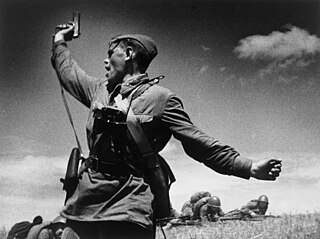 W
WAfghan Girl is a 1984 photographic portrait of Sharbat Gula, also known as Sharbat Bibi, taken by photojournalist Steve McCurry. It appeared on the June 1985 cover of National Geographic. The image is of an adolescent girl with green eyes in a red headscarf looking intensely at the camera. The identity of the photo's subject was not initially known, but in early 2002, she was identified as Sharbat Gula. She was a Pashtun child living in the Nasir Bagh refugee camp in Pakistan during the Soviet occupation of Afghanistan when she was photographed.
 W
WGuerrillero Heroico is an iconic photograph of Marxist revolutionary Che Guevara taken by Alberto Korda. It was captured on March 5, 1960, in Havana, Cuba, at a memorial service for victims of the La Coubre explosion. By the end of the 1960s, the image, in conjunction with Guevara's subsequent actions and eventual execution, helped solidify the leader as a cultural icon. Korda has said that at the moment he shot the picture, he was drawn to Guevara's facial expression, which showed "absolute implacability" as well as anger and pain. Years later, Korda would say that the photograph showed Che's firm and stoic character. Guevara was 31 years old at the time the photograph was taken.
 W
WIsambard Kingdom Brunel Standing Before the Launching Chains of the Great Eastern is a photograph taken by Robert Howlett in November 1857. It shows Brunel, the British engineer, during the troubled first attempt to launch the SS Great Eastern, by far the largest ship constructed to that date. Brunel stands before a drum of chain used during the launching of the vessel; he carries his customary cigar case and his boots and trousers are muddy. Brunel is smoking a cigar and his waistcoat is askew. His pose has been described as casual and self-assured. The image has become iconic of the industrial era and the 19th century and has been included in many published collections of photographs. It was widely reproduced at the time of the ship's eventual launch in January 1858 and again after Brunel's death in 1859.
 W
WVisual depictions of Kim Il-sung have been commonplace in North Korea since the 1940s following the example of Joseph Stalin in the Soviet Union and Mao Zedong in China. The display of Kim Il-sung portraits was made mandatory at homes in the 1970s. Gradually, they have become mandatory in certain public places as well, such as factories, airports, railway stations, and rail and subway carriages. Portraits of Kim Jong-il have been hung next to Kim Il-sung since the late 1970s. A portrait of Kim Jong-un was displayed for the first time in public in 2018.
 W
WKombat is a black-and-white photograph by the Soviet photographer Max Alpert. It depicts a Soviet military officer armed with a TT pistol who is raising his unit for an attack during World War II. This work is regarded as one of the most iconic Soviet World War II photographs, yet neither the date nor the subject is known with certainty. According to the most widely accepted version, the photograph depicts junior politruk Aleksei Yeryomenko, minutes before his death on 12 July 1942, in Voroshilovgrad Oblast, Ukraine.
 W
WKozarčanka is a World War II photograph that became iconic in the Socialist Federal Republic of Yugoslavia. Shot by Yugoslav artistic photographer Žorž Skrigin in northern Bosnia during the winter of 1943–44, it shows a smiling female Partisan wearing a Titovka cap and with a rifle slung over her shoulder.
 W
WPortrait of a married couple in Suriname or Portrait of the married couple Johannes Ellis and Maria Louisa de Hart is a daguerreotype from probably 1846. As far as we know it is the oldest surviving photograph from Suriname.
 W
WV-J Day in Times Square is a photograph by Alfred Eisenstaedt that portrays a U.S. Navy sailor embracing and kissing a total stranger—a dental assistant—on Victory over Japan Day in New York City's Times Square on August 14, 1945. The photograph was published a week later in Life magazine, among many photographs of celebrations around the United States that were presented in a 12-page section entitled "Victory Celebrations". A two-page spread faces a montage of three similar photographs of celebrators in Washington, D.C., Kansas City, and Miami, opposite the Eisenstaedt photograph that was given a full-page display on the right hand side.